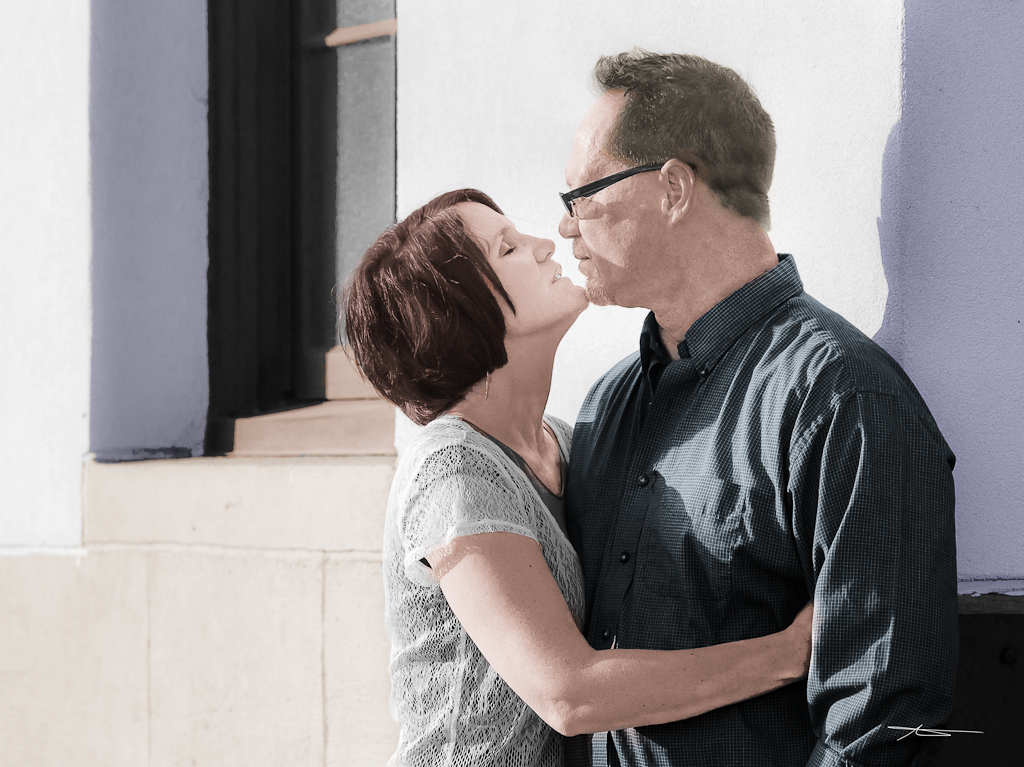We did family pictures and engagement pictures a couple of weeks ago. It was a big shoot. I did 2 studio setups and 2 locations for 5 kids and 1 adult, in 3 different groups – her kids, my kids and our kids. Then I handed my camera to my daughter and she did couple shots for the engagement, both studio and on location. First I went through the family and kid pictures which I posted in my previous entry. Then I moved on to the engagement image.
There was one picture I really liked. The composition was good, the moment was great. Lighting was alright. It was almost a wonderful shot, but it needed something. And going in I wanted to do something with some grit, some character.
I started with this (after basic LightRoom adjustments, cropping):

I went out to the internet and searched for Photoshop Instagram effects – looking for ideas. I found a couple that I liked, one using a Threshold adjustment and one on Hand Coloring.
I started with an exploratory and came up with the following:

Then I started with a new canvas and built the final, using higher resolution images:
The Steps to build the final image:
– Background copy – no changes made
- In the exploratory I added grain to this level, but decided I liked it better without
– Converted to Black and white
- I did this in two layers, one for Scott’s face and the area below the window (B&W Scott) and one for everything else. When I lightened the faces by adding Yellow and Red it was losing highlight on Scott’s forehead against the wall. And the colored area below the window was losing its detail – I wanted to maintain enough to color.
- B&W Scott (masked)
- Reds: 40
- Yellows: 60
- Greens: 40
- Cyans: 60
- Blues: 20
- Magentas: 80
- B&W Cheryl (masked)
- Reds: 79Yellows: 11
- Greens: 40
- Cyans: 79
- Blues: 71
- Magentas: 80
– I added a Threshold Adjustment layer to drop out the fine details and add a graphic feel.
- On the exploratory I got a lot more texture – but when I used it on the higher resolution image the range was much finer so I didn’t get the same amount of texture.
- Had to adjust the Threshold level and the Opacity to get the affect I wanted.
- Threshold Level: 76
- Opacity: 12%
- I had issues with the shadow areas
- Blocked the hair out on the Threshold layer.
- I had other shadow areas that were very blotchy, I decreased those shadows using the Localized Burn/Lighten layer until the blotch went away. This worked really well
– Added Blank Layer for localized Burn/Lighten
– Added Blank Layer for localized Burn/Lighten around Cheryl’s lips
– Added Curves Adjustment Layers to hand color individual areas. Selected the area to be colored, then added the Curves Adjustment Layer, which masked out the selected area
- Skin
- Scott’s Hair
- Cheryl’s Hair
- Window Shadow
- Below Window
- Window frame
- Scott’s Shirt
- Far Right Shadow
The Tutorial I used said to change the Image Mode to CMYK. That adds the black layer. But I used the default RGB image mode.

I really like the way this turned out. It gave me just enough graphic grit and dropped out some of the fine detail. That actually solved some of my lighting challenges on my face by softening the shadows. The hand color gives it a soft translucent watercolor look.
Here’s the final:

Here’s what I started with, for side by side comparison:







